| |||||||||||||||||||||||||||||||||
The procession of the Holy Friday A centuries-old tradition that comes back to life every year with religiosity and emotion
It dates back to past centuries but traditionally it is still and always lived with the mind concentrated on the religious drama, with the intense and spontaneous collective participation, accompanied by strong emotions and a deep Christian feeling. The Brontesi and the numerous strangers who gather together along the main course and in the other streets covered by the procession, relive each year with religiousness and emotion always new emotions and inner situations. Already from the morning, rigorous to an old popular proverb (“u vènniri non si canta canzùni, ca si pensa a la motti e a la passiùni”) everywhere is silence, do not sing and do not laugh, the bells do not ring because they were « related »on Thursday. As a sign of sadness, only the woody sound of the "tròccola" (see photo on other page) and the drums can be heard. In the first afternoon of every Holy Friday, the narrow country town streets get slowly crowded with believers that in bare feet carry candles, ancient confraternities with their flags (black edged) and the crucifixes adorned with the first fruits of the earth, of statues representing the passion of Christ, of altar boys, of figures and personages, singles or in groups, everyone with a precise part to play. With the same devotion and the faith of every year, the procession goes on with a centuries old direction and itinerary that, except some very small adjustment, have been handed down by our ancestors. | |||||||||||||||||||||||||||||||||
| |||||||||||||||||||||||||||||||||
A little further, in the Capuchin Church, joins in the urn with the Christ Dead, followed by the confraternity of the Third Order of San Francesco (founded in the year 1863). Along Corso Umberto join the procession from San Silvestro's church, the confraternity of Maria SS. della Misericordia (instituted in the far 1616) and, from the Church of Maria SS. della Catena, that of S. Carlo Borromeo. Gradually the participation of the devout believers and of the personages becomes ever larger. In a following one another of parts of an only act, in every church a new multitude joins the procession, that become at the end the complete representation of the passion of Christ. About one hour after starting, in front of the Church of Matrice, get into the procession the statue of the Madonna Addolorata, the various personages of the passion and the confraternity of the SS. Sacramento (one of the more ancient, about 1600). The procession proceeds till Gagini square: from the church of the Annunciated with the statue of Christ tied to the Column and the confraternity of Jesus and Mary (1700).
The composition of the procession is now complete. Everyone plays their part with fervor and devotion and, among the crowd and the swaying of the statues, they slowly continue through the narrow streets of the ancient neighborhoods of Bronte. The procession winds through the crowded streets of the historic center, retracing, in the tortuous and narrow streets, with a sequence of scenes, symbols and religious representations, all the most dramatic moments of the Passion of Christ. The fèrcoli with the statues and crucifixes of the five brotherhoods are decorated with the typical products of the season (traditionally broad beans). The sacred representation begins with the brotherhoods that parade according to the date of their foundation. The priests do not wear liturgical vestments but simply participate with the cassock carrying a crucifix in turn. They are followed by a large group of altar boys from the various parishes and the small seminary and 30 veiled girls dressed in white. | |||||||||||||||||||||||||||||||||
| |||||||||||||||||||||||||||||||||

 The procession of the Holy Friday, one of the religious manifestations more complex and archaic, recurs every year. The tortuous streets of Bronte that become a big stage in which, with intense, deeply felt religiosity, is played the Passion and the Death of Christ. Always intense and spontaneous is the collective participation supported by strong emotions and religious feelings.
The procession of the Holy Friday, one of the religious manifestations more complex and archaic, recurs every year. The tortuous streets of Bronte that become a big stage in which, with intense, deeply felt religiosity, is played the Passion and the Death of Christ. Always intense and spontaneous is the collective participation supported by strong emotions and religious feelings.








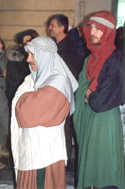



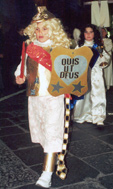

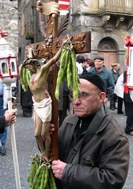
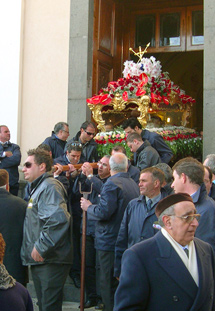 The sacred representation begins at around four o'clock in the church of the
The sacred representation begins at around four o'clock in the church of the 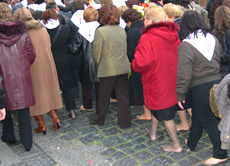















 Lastly, the four magnificent statues of “Christ at the Column”, the Crucifix, the Sorrowful Madonna and the “Dead Christ” parade, carried on the shoulders of a group of faithful volunteers, who loudly invoke divine grace in the most sincere Bronte dialect.
Lastly, the four magnificent statues of “Christ at the Column”, the Crucifix, the Sorrowful Madonna and the “Dead Christ” parade, carried on the shoulders of a group of faithful volunteers, who loudly invoke divine grace in the most sincere Bronte dialect. To a solo voice, all answer together, rising a white cloth with the only free arm,
To a solo voice, all answer together, rising a white cloth with the only free arm,








 Until 2003, the procession, after having finally traveled the Corso Umberto, returned in the evening to the inside of the church of the Matrice (SS. Trinità) and here, in an impressive crowd of faithful and curious onlookers, the sacred representation reached its culminating and most emotional moment.
Until 2003, the procession, after having finally traveled the Corso Umberto, returned in the evening to the inside of the church of the Matrice (SS. Trinità) and here, in an impressive crowd of faithful and curious onlookers, the sacred representation reached its culminating and most emotional moment.


